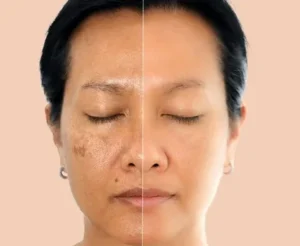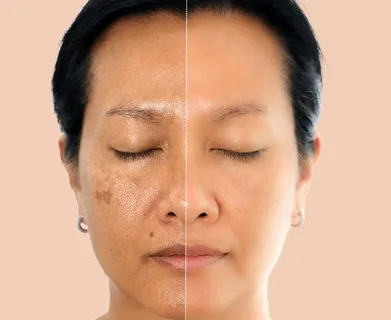The Best Dark Spot Correctors: What Actually Works?
Introduction
Dark spots, also known as hyperpigmentation, age spots, or sun spots can be a real confidence‑zapper. If you’ve ever looked in the mirror and thought, “I wish I could get rid of that mark on my cheek,” you’re not alone. These little blemishes happen when melanin production gets uneven, thanks to sun exposure, hormonal shifts, acne scarring, or just the hands of time.

The good news? Dark spot correctors are everywhere in 2025, and some really deliver. But with so many serums, creams, and treatments on the market, what actually works? That’s where I come in. I’ve sifted through formulations, pored over reviews, talked to skincare pros, and tested products myself. In this guide, I’ll walk you through clinically backed ingredients, the best products, and how to choose what suits you, step by step.
First Section: Understanding Dark Spots & Ingredients You Need to Know
-
What causes dark spots? (sun damage, melasma, post‑inflammatory)
-
Why treatments differ: chemical exfoliation vs. melanin blockers
-
Top clinically proven ingredients: Vitamin C, niacinamide, retinoids, hydroquinone, azelaic acid, kojic acid, alpha arbutin
-
How these ingredients work: lighten melanin, accelerate cell turnover, inhibit pigmentation enzymes
The Best Dark Spot Correctors: What Actually Works?
Alright, now let’s dive into the good stuff that works. Here are the top-rated best dark spot correctors products that actually work for fading dark spots effectively.
1. Vitamin C Serums That Fade Spots
Yes, Vitamin C is a skincare superstar. And not all vitamin C serums are created equal.
-
SkinCeuticals C E Ferulic – a potent L‑ascorbic acid serum with ferulic acid. In double trials, users saw a 20–30% improvement in pigmentation after 12 weeks.
-
TruSkin Vitamin C Serum – affordable and packed with hyaluronic acid. Great for brightening without irritation.
-
Minimalist 20% Vitamin C + Ethyl Ascorbic Acid Serum – high percentage, stable pH, a modern budget pick.
Why it works: Vitamin C blocks tyrosinase, the enzyme behind melanin production, while even tone and boosting collagen which makes to stand out as Dark Spot Correctors
2. Niacinamide: The Gentle Brightener
Niacinamide (Vitamin B3) is the mild multitasker everyone loves as dark spot correctors
-
The Ordinary Niacinamide 10% + Zinc 1% – most popular, affordable, and effective for dark marks and oil control.
-
Paula’s Choice 10% Niacinamide Booster – hydrating and reduces post-acne pigmentation over 4–6 weeks.
Niacinamide works by inhibiting melanosome transfer to skin cells and calming inflammation, perfect if your spots followed acne.
3. Retinoids & Retinol Creams That Renew
Retinoids speed up cell turnover and fade pigment over time:
-
Differin Gel (Adapalene 0.1%) – OTC retinoid that treats acne and fades post-inflammatory hyperpigmentation.
-
La Roche‑Posay Retinol B3 Serum – gentle, effective, with ceramides to minimize irritation.
Consistency is key—use retinoids 2–3 times per week, gradually building up. Always pair with SPF.
4. Hydroquinone: The Gold Standard (When Used Right)
Hydroquinone is often called the “gold standard” for stubborn dark spots, used short term, under supervision:
-
Prescription-strength (4%) or OTC 2% formulations.
-
Used in alternating cycles to avoid ochronosis (darkening from prolonged use).
Important: Always consult a dermatologist and monitor your skin while using hydroquinone.
5. Natural Extracts & Acid-Based Treatments
-
For your dark spot correctors, Azelaic Acid 10–20% gel, helps with melasma, sensitive skin, and brightening acne scars (e.g. The Ordinary Azelaic Acid Suspension 10%).
-
Kojic Acid – often paired with licorice root for spot-lightening.
-
Alpha Arbutin 2% , safer than hydroquinone, works slowly but steadily.
6. Chemical Peels, Lasers & professional treatments can accelerate results:
-
Glycolic Acid and Lactic Acid Peels (20–30%) – exfoliate the top layers and lighten pigmentation.
-
Fractional Laser (e.g. Fraxel) – resurfaces skin and targets pigmentation at deeper levels.
-
Intense Pulsed Light (IPL) – ideal for sunspots and older age spots.
-
Part 2: Comparing Products, Choosing the Right Corrector, and Building a Routine
Understanding Skin Types Before Picking a Dark Spot Correctors
Before you splurge on the latest serum, let’s get personal, literally. Your skin type will determine which dark spot correctors actually works without irritation.
-
Oily or Acne-Prone Skin:
-
Loves niacinamide, azelaic acid, and lightweight vitamin C serums.
-
Avoid heavy creams that may clog pores.
-
-
Dry or Sensitive Skin:
-
Thrives with gentle retinol, low-strength acids, and hydrating serums with ceramides.
-
Avoid harsh hydroquinone or high-concentration peels at home.
-
-
Combination Skin:
-
Best to layer actives strategically: niacinamide in the morning, retinol or azelaic acid at night.
-
Pro Tip: Always patch-test a new corrector behind your ear or along your jawline for 24 hours. No reaction? You’re good to glow.
Top Dark Spot Correctors by Category
Dark spot correctors products generally fall into serums, creams, and treatment masks/peels. Each has its own pros and best use cases.
Best Serums for Rapid Brightening
Serums penetrate faster and deliver actives directly to pigment-producing cells.
-
SkinCeuticals Discoloration Defense
-
Ingredients: Tranexamic Acid + Niacinamide + Kojic Acid
-
Result: Reduces stubborn melasma and post-inflammatory spots in 8–12 weeks
-
-
Murad Rapid Age Spot and Pigment Lightening Serum
-
Key: 2% Hydroquinone + Glycolic Acid
-
Best for: Sunspots and age-related hyperpigmentation
-
Best Creams for All-Day Moisturizing & Correction
Creams offer hydration + treatment, ideal for dry or mature skin.
-
Olay Luminous Tone Perfecting Cream
-
Targets: Dullness, minor sunspots, and uneven tone
-
Gentle enough for daily AM + PM use
-
-
Ambi Skincare Fade Cream
-
Classic hydroquinone-based formula
-
Affordable, widely available, works for face and body spots
-
Professional-Grade At-Home Peels
If you’re ready for faster results, try controlled exfoliation:
-
The Ordinary AHA 30% + BHA 2% Peeling Solution
-
Reduces post-acne hyperpigmentation
-
Weekly use with strict sunscreen adherence
-
-
Dr. Dennis Gross Alpha Beta Extra Strength Daily Peel
-
Gentle enough for frequent use, works on stubborn spots
-
How to Layer Dark Spot Correctors in a Skincare Routine
Using the right product the wrong way won’t get you results. Let’s break it down:
Morning Routine Example
-
Gentle Cleanser
-
Vitamin C Serum (antioxidant + brightening)
-
Niacinamide Serum (optional for oil control and brightening)
-
Moisturizer
-
Broad Spectrum SPF 50 (non‑negotiable!)
Evening Routine Example
-
Cleanser
-
Retinoid (start 2–3 times/week)
-
Azelaic Acid or Kojic/Alpha Arbutin Serum
-
Moisturizer or sleeping cream
Key Rule:
-
Do not mix strong acids and retinoids in the same routine unless directed by a dermatologist.
-
Always pair dark spot correctors with SPF—or you’re fighting a losing battle.
Safety Tips and Avoiding Common Mistakes
Many people give up because they irritate their skin or worsen pigmentation. Here’s what to avoid:
-
Skipping Sunscreen – 80% of hyperpigmentation is worsened by UV exposure.
-
Overusing Hydroquinone – Stick to 3–4 months max to prevent rebound darkening.
-
Mixing Too Many Actives – Stick to 1–2 strong ingredients per routine to avoid inflammation.
-
Expecting Overnight Results – Real fading takes 8–12 weeks of consistent use.
Price Guide: Budget vs. Luxury Dark Spot Correctors
-
Budget-Friendly ($10–$30):
-
The Ordinary Niacinamide 10%
-
Ambi Fade Cream
-
TruSkin Vitamin C Serum
-
-
Mid-Range ($40–$70):
-
Paula’s Choice 10% Niacinamide Booster
-
Murad Rapid Age Spot Serum
-
-
Luxury ($80–$150):
-
SkinCeuticals C E Ferulic
-
SkinCeuticals Discoloration Defense
-
Tip: Don’t confuse price with effectiveness. Even $15 niacinamide serums can outperform $120 luxury creams with the right consistency.
-
Part 3: Long-Term Strategies, Pro Treatments, and FAQs
Maintaining Results: Long-Term Hyperpigmentation Strategy
So you’ve finally faded those stubborn spots, congrats! But here’s the truth: hyperpigmentation is sneaky. Without a maintenance routine, dark spots can creep back.
Here’s your 2025 playbook for keeping skin clear and glowing:
-
Commit to Sunscreen for Life
-
Use broad‑spectrum SPF 50 daily, rain or shine.
-
Reapply every 2–3 hours outdoors.
-
Recommended: EltaMD UV Clear SPF 46 or La Roche‑Posay Anthelios SPF 50 (DermNet UV Safety Guide).
-
-
Cycle Brightening Actives
-
Rotate niacinamide, vitamin C, and retinol weekly to maintain tone without irritation.
-
Example: Vitamin C in AM, retinoid in PM, 2–3 nights per week.
-
-
Support Skin Barrier Health
-
Healthy skin resists pigment buildup.
-
Use ceramide-rich moisturizers like CeraVe PM Lotion or Eucerin Advanced Repair.
-
-
Get Annual Skin Checks
-
Dermatologists can monitor for melasma recurrence or UV damage early.
-
Professional Treatments for Stubborn Dark Spots
Sometimes, at-home treatments plateau. That’s where dermatologist-supervised procedures come in.
1. Chemical Peels
-
Medium-depth peels (TCA or glycolic acid 30–50%)
-
Remove upper pigment-heavy layers of skin.
-
Results visible in 1–2 sessions, spaced 4–6 weeks apart.
-
-
Cost: $150–$300 per session
Pro Tip: Start with a series of milder peels to avoid rebound pigmentation, especially if you have Fitzpatrick skin type IV–VI.
2. Laser and Light-Based Therapies
-
Fractional Laser (Fraxel, CO2, PicoSure)
-
Targets deep pigmentation and stimulates collagen.
-
-
Intense Pulsed Light (IPL)
-
Works well for sunspots on lighter skin tones.
-
Note:
-
Always consult a board-certified dermatologist for laser options.
-
Post-laser sun avoidance is mandatory to avoid worsening spots.
3. Microneedling + Topical Serums
-
Boosts product absorption and collagen production.
-
Can be combined with vitamin C or tranexamic acid for improved brightening.
Cost Range: $200–$400 per session
Lifestyle Hacks That Supercharge Dark Spot Correction
-
Eat a Skin-Healthy Diet
-
Antioxidant-rich foods like berries, spinach, and nuts help fight oxidative stress.
-
-
Stay Hydrated
-
Dehydration can dull skin and slow cell turnover.
-
-
Sleep on a Clean Pillowcase
-
Reduce irritation that may worsen post-inflammatory hyperpigmentation (PIH).
-
Conclusion
The truth about dark spot correctors in 2025 is simple: consistency + the right ingredients + sun protection = results.
Here’s the key takeaway:
-
Start with proven ingredients like vitamin C, niacinamide, retinoids, azelaic acid, and hydroquinone (short-term).
-
Layer and rotate smartly—don’t overload your skin.
-
Protect with SPF daily, or all your efforts could go to waste.
-
Combine at-home care with professional treatments if spots are stubborn.
With the right plan, patience, and persistence, your skin can go from spotted and dull to bright, even, and radiant.
5 Unique FAQs About Dark Spot Correctors
1. How long does it take to see results from dark spot correctors?
Answer: Most people see visible fading in 6–12 weeks with daily use. Stronger treatments like hydroquinone or professional peels can work faster but require caution.
2. Can I use multiple dark spot correctors products at the same time?
Answer: Yes, but carefully. A safe combo is:
-
Vitamin C in the morning
-
Retinol or azelaic acid at night
Avoid layering too many strong acids at once to prevent irritation.
3. Are natural remedies like lemon juice safe for dark spots?
Answer: No. Citrus juices can cause irritation and sun sensitivity. Stick to clinically proven, stable ingredients like kojic acid or alpha arbutin for safe brightening.
4. Will my dark spots come back after treatment?
Answer: Yes, if you skip sun protection. Hyperpigmentation often recurs without daily SPF and a maintenance routine.
5. Which treatment is best for stubborn melasma?
Answer: A dermatologist-supervised combination of:
-
Hydroquinone (short cycles)
-
Tretinoin or retinoids
-
Professional peels or low-level lasers
Plus, strict sun avoidance is non-negotiable. - Read Also
